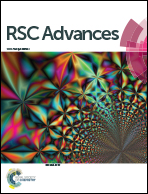Effect of organic solvent and Brønsted acid on 5-hydroxymethylfurfural preparation from glucose over CrCl3†
Abstract
In the present work, the influence of organic solvent on the mechanism of 5-hydroxymethylfurfural (HMF) preparation from glucose over CrCl3 and the role of Brønsted acid (N-methyl-2-pyrrolidone hydrogen sulfate ([NMP]HSO4), N-methyl-2-pyrrolidone bromide ([NMP]Br), N-methyl-2-pyrrolidone chlorine ([NMP]Cl), H2SO4, HBr and HCl) during the reaction were researched by a complementary computational and experimental study. It was found that dimethyl sulfoxide (DMSO) gave the lowest conversion of glucose by surrounding CrCl3, forming a six-coordinated structure (CrCl3–3DMSO). Glucose conversion in N,N-dimethylformamide (DMF) was not selective. N,N-Dimethylacetamide (DMA) and n-butyl alcohol exhibited superior selectivity towards HMF from glucose. Then the role of different Brønsted acids in DMA was expounded. On increasing the dosage of [NMP]HSO4, glucose conversion decreased. A computational study found that HSO4− could also combine with CrCl3, forming six-coordinate complexes. Addition of [NMP]Br and [NMP]Cl accelerated the generation of HMF significantly but didn’t increase the yield. An experimental method preliminarily confirmed that they were mainly responsible for fructose dehydration to HMF. A subsequent computational study further verified that the two kinds of ILs had no effect on glucose isomerization.


 Please wait while we load your content...
Please wait while we load your content...